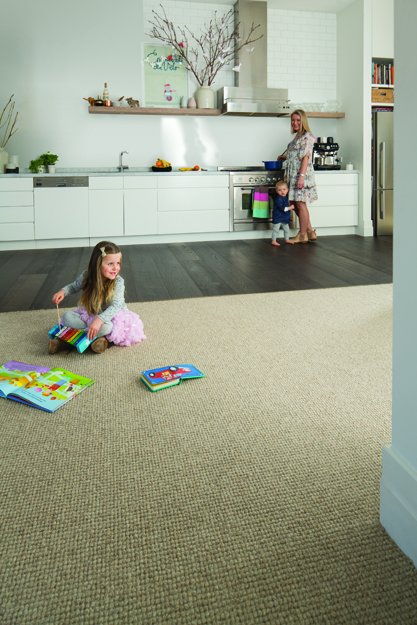Finding the best carpet for your home starts out simple and quickly becomes complicated. You know you want something that will look good in your home, feel great, and most importantly, stay that way for years to come. So you go to the local carpet store or home center and that’s when it gets complicated.
Unlike shopping for cars or clothes, a lot of different carpet styles look very similar, yet prices vary and there’s a reason for that. The fiber that is used to make the yarn that is then made into carpet is where the difference starts. How that fiber is made into yarn is the second determining factor and how it is then tufted (sewn) into carpet is the next key difference.
More than 90 percent of today’s carpet is made of synthetic fiber—nylon, polyester, triexta, or polypropylene. While each fiber has somewhat different characteristics, they are all made basically the same way. (This also includes carpets made from “Natural” fibers, such as wool and sisal.)
Once the fiber has been extruded it is bundled together and twisted into a yarn and then heat set to lock in the carpet fiber’s shape. Hundreds of needles arrayed across a machine sew the yarn into a backing. Later, a second backing will be attached to give it additional strength and stability.
How well the carpet will perform depends on how well the yarn is made and how densely the carpet is tufted. The general rule is that the more filaments twisted into a yarn, the stronger it will be and the denser the carpet is (more tufts per square inch), the better it will perform. Keep in mind though that the longer the pile height, the more likely a carpet is to crush (think of traffic paths or marks where furniture has been placed on top of the carpeting).


Choosing right carpet
You’ve decided on buying new carpet, but you want to shop smart. You already know how carpet is made and the difference between carpet styles, but what else is there to know before you buy? Lots. See below also Choosing The Best Carpet For Each Room Of Your Home?
Here are some buying carpet tips to give you the upper hand on what will soon be under your feet!
Carpet Seams: Unless your room is narrower than 15 feet, you’re going to have seams. Most carpet comes in widths of 12 feet and 15 feet — and on occasion, 13 feet. The degree of visibility of your seams depends on the texture and color you choose, as well as the lighting and furniture placement in your room.
Bending: When you carpet your stairs, its backing may show on the bends. And if it’s a looped carpet, it can snag — especially at the seams or transitions. Check our Carpet Care section for information on how to properly care for looped carpet.
Nap (Pile Shading): A carpet’s nap runs in a single direction, making pile reversal or the shading you see from a vacuum trail, completely normal for most cut pile styles. If you’re not a fan of this, window treatments and furniture placement can minimize the effect.
Quality: Let’s face it. You get what you pay for. If you want your carpet to have a great pile density and tighter twist construction (which leads to improved durability), then you’re going to want to go with a higher quality (and more expensive) product. New carpet adds value to any home, so it’s an investment worth making.
Color: Carpet covers a large part of any room, so it’s vital that you consider some basic rules when selecting its color. First off, know that once your carpet is installed, it’s going to look lighter in color than the sample you saw in the store. Don’t ask us why, that’s just the way it is — kinda like losing a sock in the dryer.
Next, recognize that color can affect the apparent size of a room. Call it a visual illusion or a trick of the light, but lighter carpet makes a room look larger and darker colors make a room look smaller and more intimate.
If you like to redecorate often or plan to move soon, go neutral. It’s much easier to imagine furniture in a room that is decorated with neutral colors.
Stains: It’s going to happen, no matter how long you hold out from sipping wine or munching on chips and salsa in your freshly carpeted room. Stain protection is an important consideration when buying carpet. Products come with various levels of protection and warranties. As the quality of a carpet increases, so does its stain protection level and warranty coverage.
Carpet Cushion: Padding or cushion is the layer of spongy material between carpet and floor. It’s the padding — not the carpet — that determines whether the carpet feels good or great under your feet.
A quality padding can help preserve a carpet’s look and can extend its life and comfort by providing tougher protection against wear and tear.
Padding is sold using quality specifications, not color specifications. The color of the sample you see in the store may not be the same color as what’s installed in your home. But as long as it feels good, who cares?!
Warranty: It’s a good idea to read the product specs and warranty coverage on the back labels of your carpet prior to purchasing. Doing so will give you the information you need to protect your investment — and eliminate any surprises down the road.

